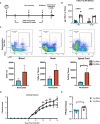Sustained Infiltration of Neutrophils Into the CNS Results in Increased Demyelination in a Viral-Induced Model of Multiple Sclerosis
- PMID: 36248905
- PMCID: PMC9562915
- DOI: 10.3389/fimmu.2022.931388
Sustained Infiltration of Neutrophils Into the CNS Results in Increased Demyelination in a Viral-Induced Model of Multiple Sclerosis
Abstract
Intracranial inoculation of the neuroadapted JHM strain of mouse hepatitis virus (JHMV) into susceptible strains of mice results in acute encephalomyelitis followed by a cimmune-mediated demyelination similar to the human demyelinating disease multiple sclerosis (MS). JHMV infection of transgenic mice in which expression of the neutrophil chemoattractant chemokine CXCL1 is under the control of a tetracycline-inducible promoter active within GFAP-positive cells results in sustained neutrophil infiltration in the central nervous system (CNS) that correlates with an increase in spinal cord demyelination. We used single cell RNA sequencing (scRNAseq) and flow cytometry to characterize molecular and cellular changes within the CNS associated with increased demyelination in transgenic mice compared to control animals. These approaches revealed the presence of activated neutrophils as determined by expression of mRNA transcripts associated with neutrophil effector functions, including CD63, MMP9, S100a8, S100a9, and ASPRV1, as well as altered neutrophil morphology and protein expression. Collectively, these findings reveal insight into changes in the profile of neutrophils associated with increased white matter damage in mice persistently infected with a neurotropic coronavirus.
Keywords: chemokine receptors; chemokines; coronavirus; neuroinflammation; neutrophils.
Copyright © 2022 Skinner, Syage, Olivarria, Stone, Hoglin and Lane.
Conflict of interest statement
The authors declare that the research was conducted in the absence of any commercial or financial relationships that could be construed as a potential conflict of interest.
Figures






Similar articles
-
Inducible Expression of CXCL1 within the Central Nervous System Amplifies Viral-Induced Demyelination.J Immunol. 2016 Feb 15;196(4):1855-64. doi: 10.4049/jimmunol.1501802. Epub 2016 Jan 15. J Immunol. 2016. PMID: 26773148 Free PMC article.
-
Induced CNS expression of CXCL1 augments neurologic disease in a murine model of multiple sclerosis via enhanced neutrophil recruitment.Eur J Immunol. 2018 Jul;48(7):1199-1210. doi: 10.1002/eji.201747442. Epub 2018 May 16. Eur J Immunol. 2018. PMID: 29697856 Free PMC article.
-
CXCR2 signaling protects oligodendrocytes and restricts demyelination in a mouse model of viral-induced demyelination.PLoS One. 2010 Jun 28;5(6):e11340. doi: 10.1371/journal.pone.0011340. PLoS One. 2010. PMID: 20596532 Free PMC article.
-
Chemokine CXCL10 and Coronavirus-Induced Neurologic Disease.Viral Immunol. 2019 Jan/Feb;32(1):25-37. doi: 10.1089/vim.2018.0073. Epub 2018 Aug 15. Viral Immunol. 2019. PMID: 30109979 Free PMC article. Review.
-
ELR(+) chemokine signaling in host defense and disease in a viral model of central nervous system disease.Front Cell Neurosci. 2014 Jun 17;8:165. doi: 10.3389/fncel.2014.00165. eCollection 2014. Front Cell Neurosci. 2014. PMID: 24987333 Free PMC article. Review.
Cited by
-
Mechanisms underlying the beneficial effects of physical exercise on multiple sclerosis: focus on immune cells.Front Immunol. 2023 Sep 29;14:1260663. doi: 10.3389/fimmu.2023.1260663. eCollection 2023. Front Immunol. 2023. PMID: 37841264 Free PMC article. Review.
-
Ablation of microglia following infection of the central nervous system with a neurotropic murine coronavirus infection leads to increased demyelination and impaired remyelination.J Neuroimmunol. 2023 Aug 15;381:578133. doi: 10.1016/j.jneuroim.2023.578133. Epub 2023 Jun 17. J Neuroimmunol. 2023. PMID: 37352687 Free PMC article.
-
Neutrophils and galectin-3 defend mice from lethal bacterial infection and humans from acute respiratory failure.Nat Commun. 2024 Jun 3;15(1):4724. doi: 10.1038/s41467-024-48796-y. Nat Commun. 2024. PMID: 38830855 Free PMC article.
-
Neutrophils, NETs and multiple sclerosis: a mini review.Front Immunol. 2025 Jan 28;16:1487814. doi: 10.3389/fimmu.2025.1487814. eCollection 2025. Front Immunol. 2025. PMID: 39935468 Free PMC article. Review.
-
Proteomic analysis reveals candidate molecules to mediate cortical pathology and identify possible biomarkers in an animal model of multiple sclerosis.Front Immunol. 2025 Feb 13;16:1505459. doi: 10.3389/fimmu.2025.1505459. eCollection 2025. Front Immunol. 2025. PMID: 40018028 Free PMC article.
References
Publication types
MeSH terms
Substances
Grants and funding
LinkOut - more resources
Full Text Sources
Medical
Molecular Biology Databases
Miscellaneous

